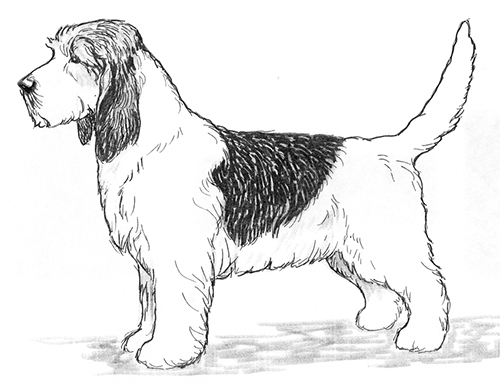Grand Basset Griffon Vendeen
Scenthound Group
The goals and purposes of this breed standard include: to furnish guidelines for breeders who wish to maintain the quality of their breed and to improve it; to advance this breed to a state of similarity throughout the world; and to act as a guide for judges.
Breeders and judges have the responsibility to avoid any conditions or exaggerations that are detrimental to the health, welfare, essence and soundness of this breed, and must take the responsibility to see that these are not perpetuated.
Any departure from the following should be considered a fault, and the seriousness with which the fault should be regarded should be in exact proportion to its degree and its effect upon the health and welfare of the dog and on the dog’s ability to perform its traditional work.
History
The Grand Basset Griffon Vendeen originated in France. It is derived, as are all the Bassets, from the larger, longer-legged hounds, in this case from the Grand Griffon. This breed is the fastest of all the scenthound bassets and is excellent on hare, but is used on all furry game.
The Grand Basset Griffon Vendeen was recognized by the United Kennel Club January 1, 1996.
General Appearance
Slightly elongated, with straight legs and the general structure of a Basset, the Grand Basset Griffon Vendeen is balanced and elegant.
Characteristics
A courageous, passionate hunter, the Grand Basset Griffon Vendeen is tenacious and can be stubborn.
Head
SKULL
The skull is long, not too wide, and convex in profile. The occiput is well developed and the stop is well defined.
MUZZLE
The muzzle is longer than the skull. It is squared off at the end, and slightly convex in profile. It is well chiseled below the eyes. The lips are quite pendulous and covered with a moustache.
TEETH
The Grand Basset Griffon Vendeen has a complete set of evenly spaced, white teeth meeting in a scissors bite.
Fault: Level bite.
Disqualifications: Overshot or undershot bite.
NOSE
The nose is prominent, with well opened nostrils. It is black except in white and orange coats, when it may be brown.
Fault: Butterfly nose.
Disqualification: Dudley nose.
EYES
The eyes are large, dark and oval in shape, with tight lids. The expression is friendly and intelligent.
Fault: Light eyes.
Disqualifications: Wall eyes.
EARS
The ears are low set, below the level of the eye. They are supple, narrow and fine, and must reach beyond the end of the nose. They are well turned inward.
Faults: Ears set high, short ears, straight ears that do not turn inward.
Neck
The neck is long, robust and well muscled, without dewlap.
Forequarters
The shoulders are long, clean and oblique.
FORELEGS
Straight, with a strong, thick forearm that has bone that is dense but lean. The elbows should be in line with the body but not tight. The wrists should never touch.
Disqualifications: Crooked or half crooked forelegs.
Body
The body is that of a Basset but avoids excessive length. The chest is broad and let down to the elbow. The ribs are rounded, but the thorax is slightly less broad at elbow level to facilitate movement. The withers are slightly protruding and the back is long, broad and very straight. The loin is solid, well muscled and slightly arched. The flank is very full, never tucked up.
Hindquarters
The hindquarters are solid. The hips are apparent.
HIND LEGS
The thighs are strongly muscled but not too rounded. The hocks are wide and angulated, never straight. Seen from the rear, the pasterns are vertical.
Feet
Strong and tight, with hard pads and solid nails.
Tail
Set quite high, thick at the base and tapering to the end, the tail is quite long and is carried gaily in saber fashion. Never on the back or bent at the tip.
Disqualification: Kinked tail.
Coat
Hard, not too long, and flat, not silky nor wooly. The fringes should not be too apparent. The eyebrows are well pronounced, but do not cover the eye.
Faults: Insufficient coat. Fine coat.
Disqualification: Wooly coat.
Color
Black with white spotting (white and black). Black with tan markings (black and tan). Black with light tan markings. Fawn with white spotting (white and orange). Fawn with black mantle and white spotting (tricolour). Fawn with black overlay. Pale fawn with black overlay and white spotting. Pale fawn with black overlay. Traditional names: hare colour, wolf colour, badger colour or wild boar colour.
Disqualifications: Solid white or solid black.
Height
Height at the withers for males is 15.5 to 17 inches. For females, it is 15 to16.5 inches.
Gait
Free, easy, and harmonious.
Eliminating Faults
(An Eliminating Fault is a Fault serious enough that it eliminates the dog from obtaining any awards in a conformation event.)
Over or under size.
Disqualifications
(A dog with a Disqualification must not be considered for placement in a conformation event, and must be reported to UKC.)
Unilateral or bilateral cryptorchid.
Viciousness or extreme shyness.
Albinism.
Overshot or undershot bite.
Dudley nose.
Wall eyes.
Crooked or half crooked forelegs.
Kinked tail.
Wooly coat.
Solid white or solid black.

Looking for a Dog?
Find a dog that will fit your family.
Note: The breeders on this list are not endorsed by UKC.
Revised July 1, 2009
©Copyright 1996, United Kennel Club
